1. The Russian Revolution
a) The Russian Empire under Nicholas II
Before the Revolution, in political terms Russia was an autocracy. In other words, the tsar was an absolute monarch, chosen by God to rule the country without the participation of the people. There was no Constitution, division of powers or representative Parliament. The power of the tsar was based on the army and the Orthodox Church. As a result, the stability of the Empire depended on military success in frequent wars.

Wikimedia Commons
As a matter of fact, Russia was a vast and backward country, populated mostly by peasants, since agriculture was the main economic activity. The land was in the hands of a reduced number of aristocrats and large landowners. Nevertheless, a weak industrialization process had begun around the largest cities such as Moscow or St Petersburg, thanks to foreign investments.
Although political parties were forbidden, at the end of the XIXth century the Russian Social Democratic Party was created under the ideological influence of Karl Marx. At the beginning of the following century this illegal party was divided into two branches: the Mensheviks and the Bolsheviks (led by Vladimir Ilich Lenin). Both wanted to see radical changes in Russia, but the Bolsheviks believed that transformation could come only through a violent revolution. The political thought of Lenin was based on the assumption that only a strong an organized workers' party would be able to bring about the revolution by leading the proletariat. Marx thought that the revolution would start by a spontaneous movement of the proletariat.
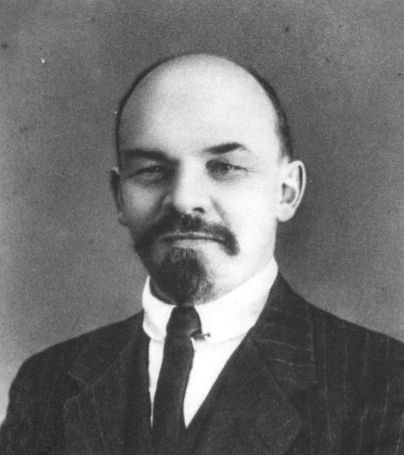
Wikimedia Commons
b) The 1905 Revolution
Both Russia and Japan were eager to expand their areas of influence over Korea and Manchuria in China. In the subsequent Russo-Japanese war in 1904, a decadent Russia was defeated by a newly industrialized country. Military defeat immediately meant troubles at home. A peaceful demonstration of workers led by a priest took place before the Winter Palace in St Petersburg, the residence of the tsar, in order to demand better social conditions. But the government ordered the imperial guard to charge against the people, and many were killed. This fact brought discredit to the tsar and favoured new riots; even the sailors of the battleship Potemkin in Odessa mutinied.
Nevertheless, the tsar agreed to create a Parliament or Duma under a new Constitution, although the ultimate political and legislative decisions remained in the imperial hands. In fact the Duma was in a permanent conflict with the tsar, who dismissed the assembly twice before the First World War.
c) The February Revolution
Again, the war was seen as an opportunity to unify all Russians against the common enemy -now Germany and Austria-Hungary. But the lack of efficiency of the Russian army made it impossible to obtain a quick victory, and consequently thousands of soldiers were lost on the battlefields. Moreover, the diversion of resources to the war and the raising military expenses led to a severe economic crisis and food shortages. The tsar lost almost all popular and political support, and people began to organize the soviets, or assemblies composed by soldiers and peasants. The soviets constituted a powerful opposition and a parallel government.
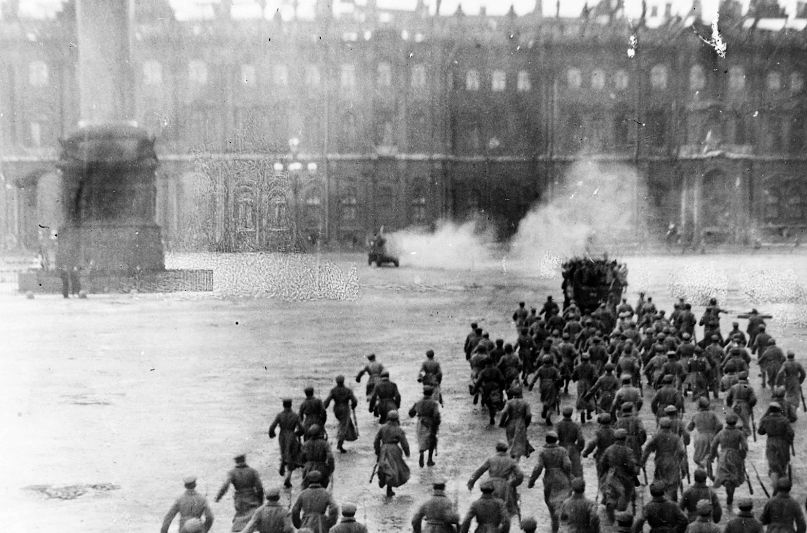
Wikimedia Commons
Finally, the tsar abdicated in February 1917. A provisional government was formed, presided by prince Lvov, who was replaced by the socialist Alexander Kerensky. Since he refused to finish the war the position of his government was more and more challenged by the soviets, above all the Petrograd Soviet. The soviets were strongly influenced by the Bolshevik party, small but very active on the troubled Russian political arena. Bolsheviks created also a militia, the armed branch of the party -the Red Guard. In fact, Kerensky was trapped between the radicalism of the Bolsheviks and the counter-revolutionary movements. One of these was the attempted coup d'état of general Kornilov, that pushed Kerensky to ask the Bolsheviks for support.
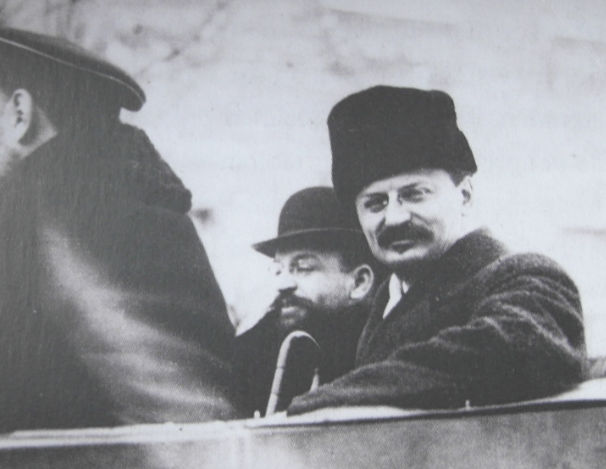
Wikimedia Commons
It was the moment for the Bolsheviks. Lenin came back to Petrograd from exile, and Trotsky organised the imminent revolution. In October, the Red Guard occupied the key positions of the capital, and the battleship Aurora threatened the Winter Palace, now the governmental see. Bolsheviks seized power and Lenin declared the Soviet Republic.
We have already said above, and shall show more fully later, that the theory of Marx and Engels of the inevitability of a violent revolution refers to the bourgeois state. The latter cannot be superseded by the proletarian state (the dictatorship of the proletariat) through the process of 'withering away", but, as a general rule, only through a violent revolution. The panegyric Engels sang in its honor, and which fully corresponds to Marx's repeated statements (see the concluding passages of The Poverty of Philosophy and the Communist Manifesto, with their proud and open proclamation of the inevitability of a violent revolution; see what Marx wrote nearly 30 years later, in criticizing the Gotha Programme of 1875, when he mercilessly castigated the opportunist character of that programme) - this panegyric is by no means a mere "impulse", a mere declamation or a polemical sally. The necessity of systematically imbuing the masses with this and precisely this view of violent revolution lies at the root of the entire theory of Marx and Engels. The betrayal of their theory by the now prevailing social-chauvinist and Kautskyite trends expresses itself strikingly in both these trends ignoring such propaganda and agitation.
The supersession of the bourgeois state by the proletarian state is impossible without a violent revolution. The abolition of the proletarian state, i.e., of the state in general, is impossible except through the process of "withering away".
A detailed and concrete elaboration of these views was given by Marx and Engels when they studied each particular revolutionary situation, when they analyzed the lessons of the experience of each particular revolution. We shall now pass to this, undoubtedly the most important, part of their theory.
Vladimir Ilich Lenin: The State and the Revolution, 1917
d) Communism and civil war
The first measure of the new government was to make peace with the Central Powers. The treaty of Brest-Litovsk was signed on March 1918: Russia renounced to Finland, Estonia, Latvia and Lithuania, Poland, Belarus and Ukraine. Most of these countries became independent, except Ukraine, that was one of the founder States of the future Soviet Union.
The Bolshevik government abolished private property and controlled banks, industries and communications. The land was also nationalised and confiscated from large landowners and the Church -the so-called War Communism. Nevertheless, these measures worsened the chaotic economic situation of the country after the war. Agriculture and industrial productions fell dangerously, and the new communist State was constantly threatened by strikes and revolts. Then Lenin began to eliminate political opposition. In July 1918 the former tsar and his family were executed in Ekaterimburg.
A civil war broke out in Russia between Reds (Communists) and Whites (counter-revolutionaries) supported by the former allies of tsarist Russia. The efficient organisation of the Red Army (the successor of the Red Guard) under the guidelines of Trotsky gave the victory to the Communists in 1920. The Union of Soviet Socialist Republics or USSR, a consolidated Communist Federation, was born in 1922.
After the victory in the civil war, Lenin implemented the New Economic Policy, a compromise between pure Communism and market economy. Large industries, banks and communications were still controlled by the State, but small private industries and agriculture exploitations were tolerated. The NEP was the basis for the economic reconstruction of the country.
2. Stalinism
a) The dictatorship
After the death of Lenin in 1924, a struggle for power in the USSR started between the followers of a permanent revolution to expand all over the world (Trotsky) and Josif Stalin, who wished to consolidate the revolution in the new communist State (socialism in one country). Stalin concentrated all power and eliminated political rivals, including Trotsky, who left the country and was assassinated in Mexico on his orders. Then began the dictatorship of the communist party (instead of the dictatorship of the proletariat) led by the iron will of Stalin -"man of steel".
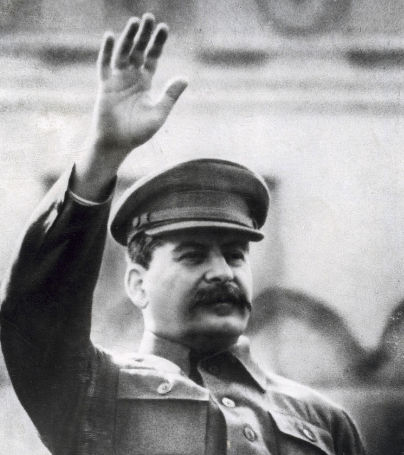
Wikimedia Commons
Opposition within the communist party was eradicated. After the economic problems of the collectivization and planned programs, in 1934 a sector of the party wanted to revise the decisions taken by Stalin. The dictator reacted with a purge of political opponents: 11 million people were sent to forced work camps in Siberia or executed.
b) Economic policy
The Soviet regime gave priority to economic development based on collectivization of agriculture and an urgent industrialization. The main objective of Stalin was to make the USSR a great industrial power, with an emphasis on heavy industry, since iron, steel and machinery were the basis of a strong military power. The Five-Year Plans were aimed to transform the economic basis of the country, through the implementation of defined (and often unrealistic) production targets. The decision and execution of the Plans were centralized in a State institution, the Gosplan.
Agriculture was collectivized. The State reorganized completely Soviet agriculture through the expropriation of lands (a movement against the kulaks, little landowners accused of raising the price of grains) and the creation of State-owned cooperatives managed by the peasants themselves (kolkhoz), or by an appointed official (sovkhoz). Production was also decided by the central government, and delivered to the State at a low price; access to private market was severely limited. The result of the collectivization effort was a complete disaster: planned quotas were never met, since State prices were not incentive enough for peasants. The richest areas of the country, such as Ukraine, saw their production of grain fell drastically. Scarcity of agriculture products led to famine levels, and 3-4 million people died of starvation. 10 million peasants migrated to cities, although the State tried to stop them by issuing internal passports in 1932.
By 1939, the objectives of development of Stalin were strategically successful, but emphasis on heavy industry meant the scarcity of consumer goods (clothes, housing), the introduction of rationing and the sacrifice of people.
REMARKS ON A SUMMARY OF THE MANUAL OF THE HISTORY OF THE U.S.S.R. 8 August 1934
The group presided over by Vanag has not accomplished its task and has not even understood it.
.The authors of the summary appear to have forgotten that the Russian revolutionaries are recognized to be the continuators and pupils of Marxist thought. In the summary, the ravages of the first imperialist war and the role of Tsarism in this war are not shown up, in as much as the dependence of Russian Tsarism on Russian capitalism and the dependence of Russian capitalism on Western Europe, is not brought out. Also the importance of the October Revolution which liberated Russia from her semi-colonial situation remains undefined.
The summary does not acknowledge the existence of a European political crisis on the brink of a world war, which will be brought about by the decadence of bourgeois democracy and parliamentarianism. Also the importance of the Soviets from the viewpoint of universal history, as the representatives of the proletarian democracy, organs of the liberation of workers and peasants from capitalism remains undefined.
The summary does not acknowledge the inner party struggle of the Communist Party of Russia, nor the struggle against Trotskyism and petty-bourgeois counter-revolution. And thus to continue. We judge a radical revision of this summary to be indispensable in the light of the propositions stated above, and it is necessary also to realise that this necessitates a manual where each word and each concept must be weighed and not just an unclear review which substantiates not more than idle and irresponsible chatter. .
STALIN - IDANOV - KIROV
(J. V. Stalin: Works, vol. 14, 1978)
3. The Great Depression
a) The basis
The twenties were a period of general prosperity in Europe and the USA. Europe had recovered its pre-war industrial levels of production. Nevertheless, there was soon a problem of overproduction. European industrial and agricultural production was added to that of the USA, and as a consequence the amount of stocks increased in certain sectors. Prices of industrial goods and agriculture dropped.
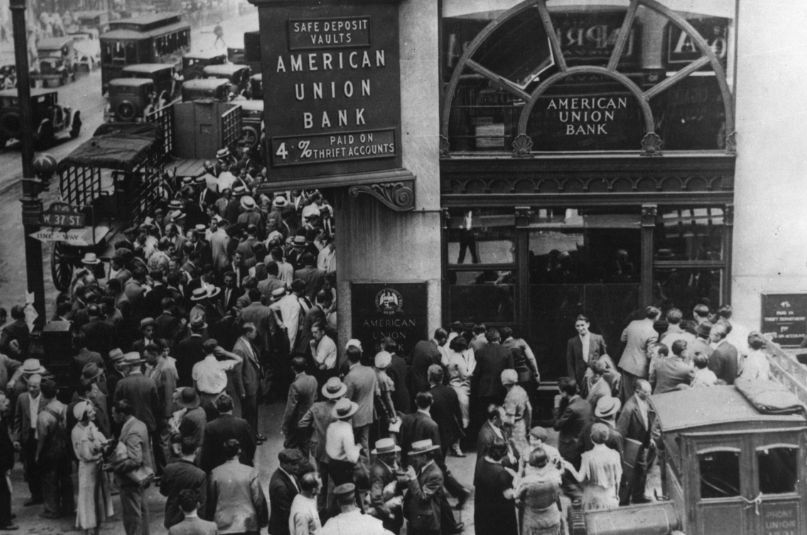
Wikimedia Commons
In spite of this process of overproduction, the USA enjoyed a stock-exchange boom. Wages, consumption and the value of industrial stocks were high. Enterprises covered their lack of benefits with easily obtained bank loans, since their value remained unchanged. But the stocks were overvalued and speculative movements spread, distracting capitals from productive investments.
b) The crisis of 1929 and its repercussions
On Black Thursday (24 October 1929), thousands of investors in panic sold their stocks on the New York Stock Exchange. Stock prices were reduced to less the value of the paper where they were printed. After the stock-exchange collapse, the banks tried in vain to collect their debts, so that many of them went bankrupt. Financial crisis led immediately to a general and deep economic depression, with rising levels of unemployment and poverty, a decrease of wages and a falling demand. Banks were unable to afford capital payments, and useless queues were formed in front of the closed doors of the financial institutions to recover the deposits and savings of a large amount of people. By 1933, there were 15 million unemployed, and the industrial production had fallen to 50%.
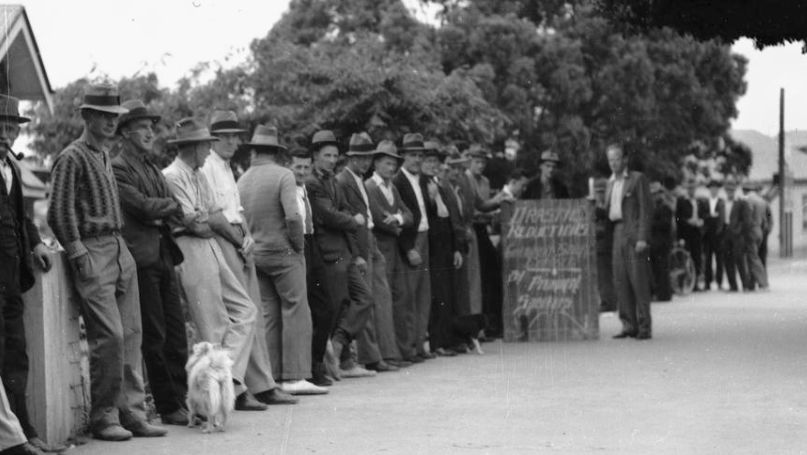
Wikimedia Commons
After the crash of October, American investors began to withdraw their capital out from Europe. Since European wealth was based on American loans, the crisis expanded to European countries, first of all to Germany and Austria, whose financial systems collapsed. There were 4 million German unemployed by the end of 1930. The result was a decrease of business and industrial activities, unemployment and inflation. Finally, the rest of the world, which depended on the developed economies (colonies, raw materials exporters) suffered also the impact of economic crisis. A system of trade barriers was set up to protect the financial, industrial and commercial interests of formerly linked economies.
c) The New Deal
When Democrat Franklin Delano Roosevelt won the presidential election of 1932, he initiated a policy of State intervention in the economy. American government invested in large public works (roads, barrages, airports) in order to reduce the number of unemployed. It launched social legislation in order to guarantee minimum wages and social security for pensions and unemployed -the welfare State. The banking system and agriculture prices were also supported. Nevertheless, the recovery of the American economy would not take place but during World War II.
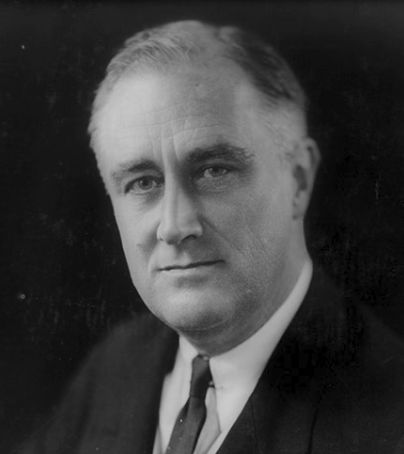
Wikimedia Commons
4. Fascism and Nazism
a) Ideology
During the 20s and 30s, most of the European countries changed their democratic systems for dictatorial regimes. They were characterized by an extreme control of all citizens, in order to get a massive identification with the regime and its objectives. Devotion to nation-state and the leader who guides it was the sacred duty for individuals. In order to understand the very nature of these authoritarian regimes, it is necessary to differentiate between an activist and a limited style of politics:
-First, within a limited style of politics, the community is based on the law, which is the expression of the general will, and at the same time a limitation for governmental action. But within an activist style of politics, there is not such a limit, because the guiding principle is ideology. Ideology is the new expression of the community. Nevertheless, ideology does not provide effective restrictions for the abuse of power.
-Second, there is a clear distinction between the private and public aspects of life in a limited style of politics, which is not existent in a dictatorship. Individual citizens are granted democratic rights and freedoms, but in a dictatorial State an individual is of no importance; what matters is the collective fate of the nation.
The Fascist doctrine is based on the following principles:
1. Supremacy of the State. Individuals are blindly identified with the principles and goals of the State and follow them without discussion or opposition. The nation prevails over the person, and controls all aspects of individual life through different organizations (youth, women, workers).
2. Ruling minority. Equality of men is a fallacy of the "cancer of democracy". Only a selected ruling class is prepared to lead the country, the elite of the one party (Fascist or Nazi). Women are reduced to their role as mothers and homemakers (the three Nazi "k": kinder, küche, kirche or children, kitchen, church).
3. The leader. The totalitarian State is ruled by a charismatic leader (Duce, Führer, Caudillo), an exceptional man who determines the fate of the country and its citizens. His decisions are infallible laws, since he is always right (Mussolini ha sempre ragione).
4. Mistrust in reason. Fanaticism and irrational obedience to the dictates of the leader implies a rejection of the traditional legacy of rational thought (since classical Greece, the Renaissance and the Enlightenment, reason has been used as an instrument to understand Nature and human behaviour).
5. Exacerbated nationalism. National community is exalted as the most perfect expression of the people. A great nation needs a geographical space large enough to provide the community with the means of its greatness. A superior people have the right to conquer a vital space (Lebensraum), against inferior nations (e.g. Germans/Slavs).
6. Anti-communism. The Marxist conception of a society divided into two antagonistic classes and the need for a revolution of the proletariat is rejected. Order and social unity to strengthen the nation are the prerequisites for a powerful State. In fact, Fascism is a "third way" between
7. Anti-liberalism. There is no need for the democratic balance of powers, or for the democratic game of the political parties, because it implies a limitation of the totalitarian State.
.If we admit the significance of blood, that is to say, if we recognize the race as the fundamental element on which all life is based, we shall have to apply to the individual the logical consequences of this principle. In general I must estimate the worth of nations differently, on the basis of the different races from which they spring, and I must also differentiate in estimating the worth of the individual within his own race. The principle, that one people is not the same as another, applies also to the individual members of a national community (.).
The first consequence of this fact is comparatively simple. It demands that those elements within the folk-community which show the best racial qualities ought to be encouraged more than the others and especially they should be encouraged to increase and multiply.
(.) A philosophy of life which repudiates the democratic principle of the rule of the masses and aims at giving this world to the best people - that is, to the highest quality of mankind - must also apply that same aristocratic postulate to the individuals within the folk-community. It must take care that the positions of leadership and highest influence are given to the best men. Hence it is not based on the idea of the majority, but on that of personality.
(.) Thus at the origin of the material civilization which flourishes today we always see individual persons (.). The broad masses do not invent, nor does the majority organize or think; but always and in every case the individual man, the person (.). Such men of brains are selected mainly, as I have already said, through the hard struggle for existence itself. In this struggle there are many who break down and collapse and thereby show that they are not called by Destiny to fill the highest positions; and only very few are left who can be classed among the elect (.). The destructive workings of Judaism in different parts of the national body can be ascribed fundamentally to the persistent Jewish efforts at undermining the importance of personality among the nations that are their hosts and, in place of personality, substituting the domination of the masses. The constructive principle of Aryan humanity is thus displaced by the destructive principle of the Jews. (.).
Marxism represents the most striking phase of the Jewish endeavour to eliminate the dominant significance of personality in every sphere of human life and replace it by the numerical power of the masses. In politics the parliamentary form of government is the expression of this effort. We can observe the fatal effects of it everywhere.
Hitler: Mein Kampf, vol. 2, Ch. 4
b) Italian Fascism
Benito Mussolini was the founder of the Fascio di Combattimentoin 1919, a precedent of the Fascist party. A paramilitary militia (the black shirts or squadristi) was organized as the armed branch of the movement. The Italian social and economic crisis favoured a general climate of confrontation and violence between workers and employers. In such conditions, Fascism attracted conservative adherents and economic supporters to his movement.
During a general strike in August 1922, the black shirts kept all basic services (trains, buses) working; in October, Mussolini announced a march on Rome if they were not given power. Under this pressure, the government decided to declare the state of emergency, but king Vittorio Emanuele III refused. After the resignation of the cabinet, the king appointed Mussolini as new head of government.

Wikimedia Commons
Step by step, Mussolini created a dictatorship. After the elections of 1924 (won by the Fascists), the socialist MP Matteotti criticized the Fascist programme and actions, and some days later he was kidnapped and murdered. After that, Mussolini suspended the constitutional civil rights, introduced press censorship, and outlawed non- Fascist political parties. Thus he became the Duce (leader).
In terms of economic policy, State intervention in Fascist Italy organized production through mixed unions of employers and workers under the direction of the State. Investments for public works increased to reduce unemployment. The State also planned agriculture, industrial and general economic development (battle for wheat, battle for the lira, battle for births). Emphasis was made on economic self-sufficiency (autarky) and economic growth.
c) German National-Socialism. The Third Reich
Adolf Hitler joined the German Workers' Party at the end of World War I, and soon he became its leader as the National Socialist German Workers' Party (NSDAP or Nazi). The Storm Troopsor SA were the militia of the Nazi movement. In 1923 the Nazis tried a failed uprising against the Weimar Republic in Munich (the Beer Hall Putsch); Hitler was put into prison, where he wrote Mein Kampf (My Struggle), an exposition of Nazi ideology.
The Nazi Party attracted an increasing number of followers and voters at the end of the 20s, due to the deep economic depression and the general feeling of national humiliation identified with the Treaty of Versailles. The payment of war reparations was considered the main responsible of the situation of Germany. Hitler promised to restore national honour inside and outside German borders, full employment and economic growth. The parliamentary system of the Weimar Republic became a symbol of lack of efficiency, and the conservative sectors (including industrialists, aristocrats, and the military) saw Hitler as the saviour of Germany against social chaos and a Marxist revolution.

Wikimedia Commons
In January 1933, president von Hindemburg appointed Hitler as chancellor. After the burning of the Reichstag in Berlin, the Nazis blamed the Communists and Hitler declared the state of emergency, suspending constitutional rights. The subsequent Enabling Act authorised the government to rule the country without the participation of the Parliament. This was the beginning of the creation of a totalitarian State. When Hindemburg died in 1934, Hitler added the position of head of State to that of chancellor as Führer (leader).
Political parties (except the Nazi party) and trade unions were dissolved; strikes were forbidden. The federal structure of the old Republic was replaced by a centralized State. The administration, the Universities and the judiciary system were purged. A secret police (Gestapo) was in charge of the elimination of political dissidents and social minorities. The SA2 were replaced in their role of Party elite by the SS (Schutzstaffel or "protection echelon"), more structured and loyal to the Führer, under the direction of Himmler. The country was controlled by State and party organizations for all professions and ages (for example, the HitlerJugend for the youth).
Jews were persecuted: the Nuremberg Laws of 1935 forbade mixed marriages or relationships between Jews and Aryan Germans; the former were excluded from civil service and professional life, and persecuted in everyday life. During the Kristallnacht of 1938 (9-10 November), violent actions against the Jews were undertaken, and as a result synagogues and businesses were burned, and Jews killed or sent to concentration camps. The objective was to create a pure and superior race without Jews. Also other minorities were affected, such as gypsies, gays, etc. During World War II, the "Final solution" implied the systematic extermination of about 6 million Jews (the shoah), and 6 more of the considered "asocial people".
On the economic side, unemployment was solved thanks to the intervention of the State through public investments in communications (highways), armament industries, etc. The State, as in the Italian and Soviet cases, planned the agriculture and industrial productions with a view to economic autarky.
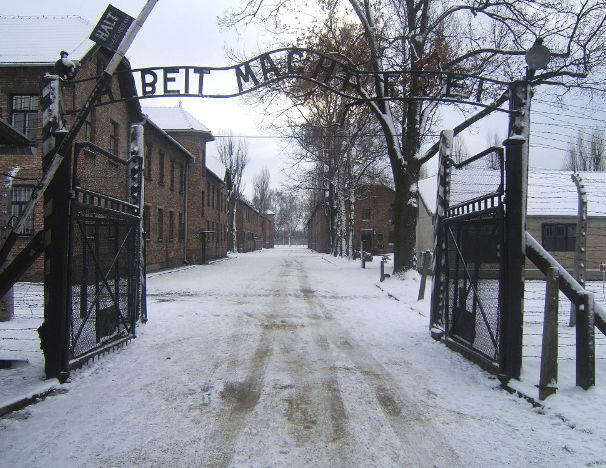
Wikimedia Commons
